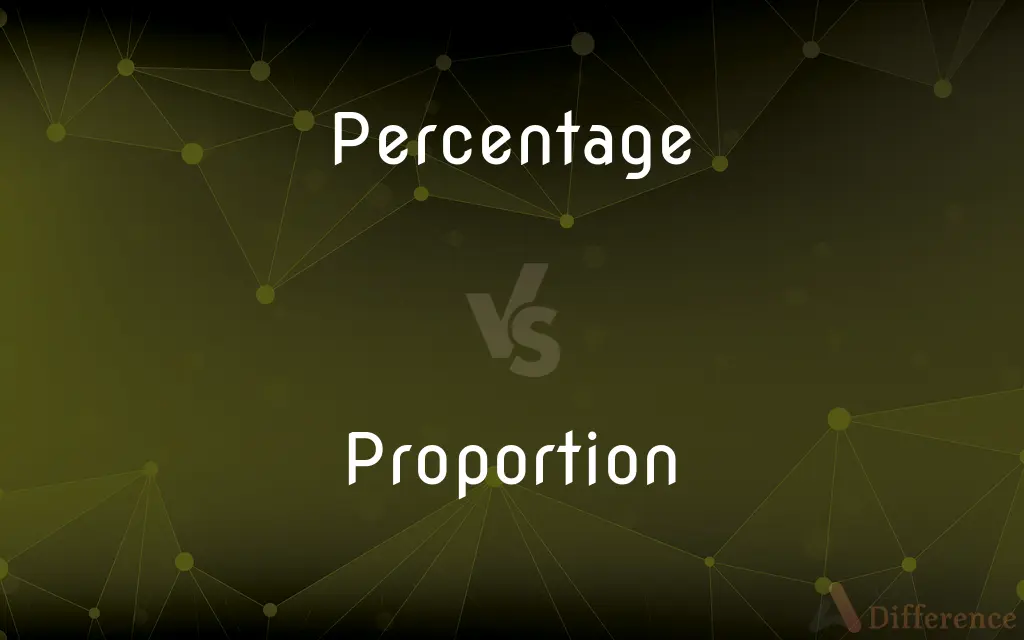Percentage vs. Proportion — What's the Difference?
By Tayyaba Rehman — Updated on September 17, 2023
"Percentage" is a fraction or ratio expressed out of 100, while "Proportion" denotes a relationship between parts of a whole or different quantities.

Difference Between Percentage and Proportion
Table of Contents
ADVERTISEMENT
Key Differences
"Percentage" and "Proportion" both quantify relationships, but in distinct manners. A "Percentage" is a specific type of proportion expressed on a scale of 1 to 100. "Proportion," on the other hand, defines a general relationship between two quantities.
Consider a group of students in a class. The "Percentage" might describe how many of them passed an exam out of 100, while the "Proportion" could describe the ratio of those who passed to those who did not.
"Percentage" always has a denominator of 100, making it easily relatable and interpretable. "Proportion" is more flexible, denoting a relationship which might not always be out of a specific number.
For businesses, understanding the "Percentage" of market share can provide a clear metric of performance in relation to competitors. Conversely, the "Proportion" of sales between different products helps visualize how each product is doing in relation to the others.
A critical thing to note is that while every "Percentage" is a proportion (since it represents part-to-whole relationships), not every "Proportion" is a percentage since it may not be out of 100.
ADVERTISEMENT
Comparison Chart
Definition
A fraction or ratio out of 100.
A relationship between parts of a whole or different quantities
Denominator
Always 100.
Varies.
Use
Easily interpretable metric.
Describes relationships between quantities.
Representation
Expressed with a "%" symbol.
Expressed as a ratio.
Flexibility
Specific to 100 scale.
Can represent any part-to-whole or part-to-part relationship.
Compare with Definitions
Percentage
A way to represent a share or portion.
The percentage of profit was higher this year.
Proportion
A relationship between two quantities.
The proportion of apples to oranges is 2:3.
Percentage
A comparative metric standardized to a base of 100.
The percentage of growth shows an upward trend.
Proportion
A comparative relation between things.
The sculpture was beautiful, but its proportions were odd.
Percentage
A fraction expressed out of 100.
The percentage of students who passed was 85%.
Proportion
A part, share, or number considered in comparative relation to a whole
The proportion of greenhouse gases in the atmosphere is rising
Percentage
A specific proportion on a scale of 1 to 100.
The percentage of apples in the basket is 20%.
Proportion
Adjust or regulate (something) so that it has a particular or suitable relationship to something else
A life after death in which happiness can be proportioned to virtue
Percentage
A rate or number per hundred.
The percentage of rainfall increased this month.
Proportion
A part or amount considered in relation to a whole
What is the proportion of helium in the atmosphere?.
Percentage
In mathematics, a percentage (from Latin per centum "by a hundred") is a number or ratio expressed as a fraction of 100. It is often denoted using the percent sign, "%", although the abbreviations "pct.", "pct" and sometimes "pc" are also used.
Proportion
A relationship between things or parts of things with respect to comparative magnitude, quantity, or degree
The proper proportion between oil and vinegar in the dressing.
Percentage
A rate, number, or amount in each hundred
A large percentage increase
The percentage of Caesareans at the hospital was three per cent higher than the national average
Proportion
A relationship between quantities such that if one varies then another varies in a manner dependent on the first
"We do not always find visible happiness in proportion to visible virtue" (Samuel Johnson).
Percentage
A fraction or ratio with 100 understood as the denominator; for example, 0.98 equals a percentage of 98.
Proportion
The agreeable or harmonious relation of parts within a whole
The statue seems out of proportion.
Percentage
The result obtained by multiplying a quantity by a percent.
Proportion
Often proportions Dimensions; size
First measure the proportions of the room.
Percentage
A proportion or share in relation to a whole; a part
The hecklers constituted only a small percentage of the audience.
Proportion
(Mathematics) A statement of equality between two ratios. Four quantities, a, b, c, d, are said to be in proportion if a/b = c/d .
Percentage
An amount, such as an allowance, duty, or commission, that varies in proportion to a larger sum, such as total sales
Work for a percentage.
Proportion
To adjust so that proper relations between parts are attained
Have you proportioned the oil in the dressing properly?.
Percentage
(Informal) Advantage; gain
There is no percentage in work without pay.
Proportion
To form the parts of with balance or symmetry
The artist proportioned the figure nicely.
Percentage
The amount, number or rate of something, regarded as part of a total of 100; a part of a whole.
A high percentage of secondary school leavers take a gap year.
Proportion
(countable) A quantity of something that is part of the whole amount or number.
Percentage
A share of the sales, profits, gross margin or similar.
She gets a percentage for every vacuum cleaner sold.
Proportion
(uncountable) Harmonious relation of parts to each other or to the whole.
Percentage
(informal) Benefit or advantage.
There was no percentage in staying at home.
Proportion
(countable) Proper or equal share.
Percentage
A certain rate per cent; the allowance, duty, rate of interest, discount, or commission, on a hundred.
Proportion
The relation of one part to another or to the whole with respect to magnitude, quantity, or degree.
The proportion of the parts of a building, or of the body
Percentage
A proportion multiplied by 100
Proportion
A statement of equality between two ratios.
Percentage
Assets belonging to or due to or contributed by an individual person or group;
He wanted his share in cash
Proportion
The "rule of three", in which three terms are given to find a fourth.
Proportion
Size.
Proportion
(transitive) To divide into proper shares; to apportion.
Proportion
(transitive) To form symmetrically.
Proportion
To set or render in proportion.
Proportion
To correspond to.
Proportion
The relation or adaptation of one portion to another, or to the whole, as respect magnitude, quantity, or degree; comparative relation; ratio; as, the proportion of the parts of a building, or of the body.
The image of Christ, made after his own proportion.
Formed in the best proportions of her sex.
Documents are authentic and facts are true precisely in proportion to the support which they afford to his theory.
Proportion
Harmonic relation between parts, or between different things of the same kind; symmetrical arrangement or adjustment; symmetry; as, to be out of proportion.
Proportion
The portion one receives when a whole is distributed by a rule or principle; equal or proper share; lot.
Let the women . . . do the same things in their proportions and capacities.
Proportion
A part considered comparatively; a share.
Proportion
The equality or similarity of ratios, especially of geometrical ratios; or a relation among quantities such that the quotient of the first divided by the second is equal to that of the third divided by the fourth; - called also geometrical proportion, in distinction from arithmetical proportion, or that in which the difference of the first and second is equal to the difference of the third and fourth.
Proportion
The rule of three, in arithmetic, in which the three given terms, together with the one sought, are proportional.
Proportion
To adjust in a suitable proportion, as one thing or one part to another; as, to proportion the size of a building to its height; to proportion our expenditures to our income.
In the loss of an object we do not proportion our grief to the real value . . . but to the value our fancies set upon it.
Proportion
To form with symmetry or suitableness, as the parts of the body.
Nature had proportioned her without any fault.
Proportion
To divide into equal or just shares; to apportion.
Proportion
The quotient obtained when the magnitude of a part is divided by the magnitude of the whole
Proportion
Magnitude or extent;
A building of vast proportions
Proportion
Balance among the parts of something
Proportion
Harmonious arrangement or relation of parts or elements within a whole (as in a design);
In all perfectly beautiful objects there is found the opposition of one part to another and a reciprocal balance
Proportion
Give pleasant proportions to;
Harmonize a building with those surrounding it
Proportion
Adjust in size relative to other things
Proportion
A part-to-whole relationship.
The proportion of blue marbles in the bag is one third.
Proportion
A harmonious arrangement or balance.
The proportion of colors in the painting was just right.
Proportion
A mathematical ratio.
The proportion of salt to water affects boiling point.
Common Curiosities
Are "Percentage" and "Proportion" the same?
No, while every percentage is a proportion, not every proportion is a percentage.
What's the base for "Percentage"?
100.
How is "Percentage" typically represented?
With the "%" symbol.
How do you convert "Percentage" to "Proportion"?
Divide the percentage by 100.
Is "Percentage" always a fraction?
It represents a fraction but is given on a scale out of 100.
Can "Proportion" be larger than 1?
Yes, proportions can be any ratio, even greater than 1.
How can "Proportion" be visualized?
As a part-to-whole or part-to-part relationship.
How is "Proportion" used in art?
To achieve balance and harmony in design.
Can "Proportions" be used in cooking?
Yes, to denote the ratio of ingredients.
Can "Proportion" be expressed as a decimal?
Yes, like 0.5 representing half.
Why is "Percentage" commonly used in statistics?
Because it's easily relatable and interpretable on a scale of 100.
What does a 50% "Percentage" mean?
It means half, or 0.5, when expressed as a proportion.
How do you calculate "Percentage"?
Divide the part by the whole and multiply by 100.
Are "Proportions" essential in architecture?
Yes, for designing balanced and harmonious structures.
Does "Percentage" always need a context?
Yes, to understand what the percentage refers to.
Share Your Discovery

Previous Comparison
Important vs. Serious
Next Comparison
Mandrill vs. BaboonAuthor Spotlight
Written by
Tayyaba RehmanTayyaba Rehman is a distinguished writer, currently serving as a primary contributor to askdifference.com. As a researcher in semantics and etymology, Tayyaba's passion for the complexity of languages and their distinctions has found a perfect home on the platform. Tayyaba delves into the intricacies of language, distinguishing between commonly confused words and phrases, thereby providing clarity for readers worldwide.














































